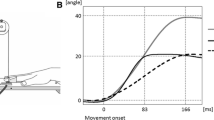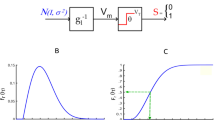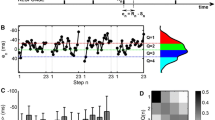Abstract
We have studied the effect of movement rate on MEG activity associated with self-paced finger movement in four subjects to determine whether the amplitude or latency of motor-evoked activity changes across a range of rates. Subjects performed a continuation paradigm at 21 distinct rates (range: 0.5–2.5 Hz) chosen because of their relevance for many types of sensorimotor coordination (e.g. musical performance). Results revealed a pair of field patterns whose topography and temporal dynamics were similar across all subjects. The strongest pattern was a movement-evoked field (MEF) that emerged during the response and exhibited one or two polarity reversals in time depending on the subject. The MEF complex was tightly coupled to the biphasic response profile but neither latency nor peak amplitude of each MEF component had significant dependence on the temporal duration between successive responses, i.e. movement rate. In contrast, the maximal amplitude of a second, weaker pattern decreased by over 50% when movement rates exceeded 1.1 Hz (inter-response interval <1 s). This pattern was characterized by a change in field line direction over the midline of the scalp and a gradual accumulation of amplitude prior to movement onset. Both characteristics are suggestive of a readiness field. The observed rate-dependent changes in this field may contribute to known transitions in sensorimotor coordination that emerge when the frequency of coordination is increased.





Similar content being viewed by others
References
Barrett G, Shibasaki N, Neshige R (1986) Cortical potentials preceding voluntary movement: evidence for three periods of preparation in man. Electroencephalogr Clin Neurophysiol 63:327–339
Cheyne D, Weinberg H (1989) Neuromagnetic fields accompanying unilateral finger movements: pre-movement and movement-evoked fields. Exp Brain Res 78:604–612
Cheyne D, Endo H, Takeda T, Weinberg H (1997) Sensory feedback contributes to early movement-evoked fields during voluntary finger movements in humans. Brain Res 771:196–202
Deecke L, Weinberg H, Brickett P (1982) Magnetic fields of the human brain accompanying voluntary movement: Bereitschaftsmagnetfeld. Exp Brain Res 48:144–148
Deecke L, Boschert J, Brickett P, Weinberg H (1983) Magnetoencephalographic evidence for possible supplementary motor area participation in human voluntary movement. In: Weinberg H, Stroink G, Kaila T (eds) Biomagnetism: applications and theory. Pergamon Press, New York, pp 369–372
Engström DA, Kelso JAS, Holroyd T (1996) Reaction-anticipation transitions in human perception-action patterns. Hum Mov Sci 15:809–832
Erdler M, Beisteiner R, Mayer D, Kaindl T, Edward V, Windischberger C, Lindinger G, Deecke L (2000) Supplementary motor area activation preceding voluntary movement is detectable with a whole-scalp magnetoencephalography system. Neuroimage 11:697–707
Fuchs A, Kelso JAS, Haken H (1992) Phase transitions in the human brain: spatial mode dynamics. Int J Bifurc Chaos 2:917–939
Fuchs A, Mayville JM, Cheyne D, Weinberg H, Deecke L, Kelso JAS (2000a) Spatiotemporal analysis of neuromagnetic events underlying the emergence of coordinative instabilities. Neuroimage 12:71–84
Fuchs A, Jirsa VK, Kelso JAS (2000b) Theory of the relation between human brain activity (MEG) and hand movements. Neuroimage 11:359–369
Haken H, Kelso JAS, Bunz H (1985) A theoretical model of phase transitions in human hand movements. Biol Cybern 51:347–356
Hari R, Antervo A, Katila T, Poutanen T, Seppänen M, Tuomisto T, Varpula T (1983) Cerebral magnetic fields associated with voluntary limb movements. Nuova Cimento 2D:484–494
Holroyd T, Endo H, Kelso JAS, Takeda T (1999) Dynamics of the MEG recorded during rhythmic index-finger extension and flexion. In: Yoshimoto T, Kotani M, Kuriki S, Nakasato N, Karibe H (eds) Recent advances in biomagnetism: proceedings of the 11th international conference on biomagnetism. Tohoku University Press, Sendai, Japan, pp 446–449
Jäncke L, Specht K, Mirzazade S, Loose R, Himmelbach M, Lutz K, Shah NJ (1998) A parametric analysis of the “rate effect” in the sensorimotor cortex: a functional magnetic resonance imaging analysis in human subjects. Neurosci Lett 252:37–40
Kelso JAS (1984) Phase transitions and critical behavior in human bimanual coordination. Am J Physiol 246:R1000–R1004
Kelso JAS, DelColle JD, Schöner G (1990) Action-perception as a pattern formation process. In: Jeannerod M (ed) Attention and performance XIII. Erlbaum, Hillsdale, N.J., pp 139–169
Kelso JAS, Bressler SL, Buchanan S, DeGuzman GC, Ding M, Fuchs A, Holroyd T (1991) Cooperative and critical phenomena in the human brain revealed by multiple SQuIDs. In: Duke D, Pritchard W (eds) Measuring chaos in the human brain. World Scientific, Teaneck, N.J., pp 97–112
Kelso JAS, Bressler SL, Buchanan S, DeGuzman GC, Ding M, Fuchs A, Holroyd T (1992) A phase transition in human brain and behavior. Phys Lett A 169:134–144
Kelso JAS, Fuchs A, Lancaster R, Holroyd T, Cheyne D, Weinberg H (1998) Dynamic cortical activity in the human brain reveals motor equivalence. Nature 392:814–818
Kornhuber HH, Deecke L (1965) Hirnpotentialänderungen bei Willkürbewegungen und passiven Bewegungen des Menschen: Bereitschaftspotential und reafferente Potentiale. Pflügers Arch 284:1–17
Kornhuber HH, Deecke L, Lang W, Lang M, Kornhuber A (1989) Will, volitional action, attention and cerebral potentials in man: Bereitschaftspotential, performance-related potentials, directed action potential, EEG spectrum changes. In: Hershberger W (ed) Volitional action. Elsevier, Amsterdam, pp 107–168
Kristeva R, Cheyne D, Deecke L (1991) Neuromagnetic fields accompanying unilateral and bilateral voluntary movements: topography and analysis of cortical sources. Electroencephalogr Clin Neurophysiol 81:284–298
Kristeva-Feige R, Walter H, Lütkenhöner B, Hampson S, Ross B, Knorr U, Steinmetz H, Cheyne D (1994) A neuromagnetic study of the functional organization of the sensorimotor cortex. Eur J Neurosci 6:632–639
Kristeva-Feige R, Rossi S, Pizzella V, Sabato A, Sabato A, Tecchio F, Feige B, Romani G-L, Edrich J, Rossini PM (1996) Changes in movement-related brain activity during transient deafferentation: a neuromagnetic study. Brain Res 714:201–208
Mayville JM, Bressler SL, Fuchs A, Kelso JAS (1999) Spatiotemporal reorganization of electrical activity in the human brain associated with a timing transition in rhythmic auditory-motor coordination. Exp Brain Res 127:371–381
Mayville JM, Fuchs A, Ding M, Cheyne D, Deecke L, Kelso JAS (2001) Event-related changes in neuromagnetic activity associated with syncopation and synchronization timing tasks. Hum Brain Mapp 14:65–80
Sadato N, Ibañez V, Deiber M-P, Campbell G, Leonardo M, Hallett M (1996) Frequency-dependent changes of regional cerebral blood flow during finger movements. J Cereb Blood Flow Metab 16:23–33
Sadato N, Ibañez V, Campbell G, Deiber M-P, Le Bihan D, Hallett M (1997) Frequency-dependent changes of regional cerebral blood flow during finger movements: functional MRI compared to PET. J Cereb Blood Flow Metab 17:670–679
Acknowledgements
This study was supported by grants from the National Institute of Mental Health (MH42900 and MH19116), the National Institute of Neurological Disorders and Stroke (NS39845) and the Human Frontier Science Program. We wish to thank Professor Dr. Lüder Deecke and his staff (especially Dagmar Mayer and Gerald Lindinger) for providing technical assistance during the data collection.
Author information
Authors and Affiliations
Corresponding author
Rights and permissions
About this article
Cite this article
Mayville, J.M., Fuchs, A. & Kelso, J.A.S. Neuromagnetic motor fields accompanying self-paced rhythmic finger movement at different rates. Exp Brain Res 166, 190–199 (2005). https://doi.org/10.1007/s00221-005-2354-2
Received:
Accepted:
Published:
Issue Date:
DOI: https://doi.org/10.1007/s00221-005-2354-2




